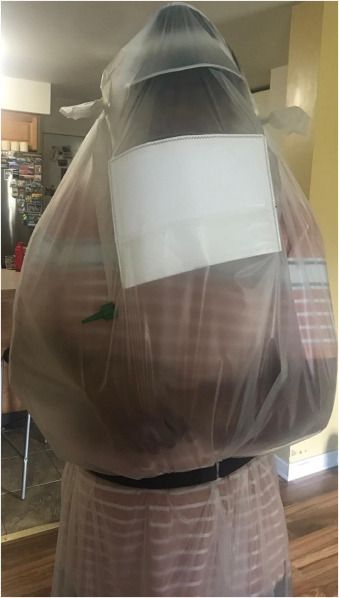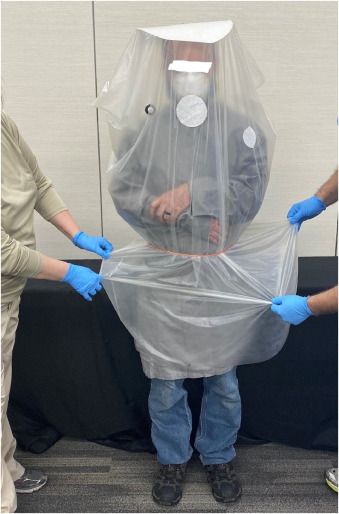Plastic Bag Prototype Shows Promise in Blocking COVID-19 Infection
Patient isolation bag could not only reduce risk of viral transmission, but could also streamline CT workflow.

Figure 3Early prototype isolation bag donning by 2 staff: An upright patient is assisted by 2 staff members for careful donning. Reproduced with permission reference 3. Courtesy: Academic Radiology

A plastic bag could help prevent COVID-19 transmission in the CT suite.
According to a new study published in the May 25 Academic Radiology, investigators, led by Amel Amalou, M.D., with the National Institutes of Health, determined a hypoallergenic plastic polymer patient isolation bag can control the risk of infection.
“The COVID-19 pandemic has the potential to completely stall radiology department throughput due to excessive delays in between patients for decontamination and airflow exchanges,” Amalou’s team wrote. “In the setting of a pandemic from droplet-transmitted novel virus and an immune-naïve populations, there is a critical clinical need for cost-effective disposable [personal protective equipment] for the infected patient’s isolation while undergoing CT procedures.”
Throughout the pandemic, CT scans have played a vital role in evaluating patients who are positive for COVID-19. But, the 30 minutes-to-60 minutes needed to disinfect the CT suite and allow for passive air exchange has been shown to slow down workflow and productivity, the study authors noted.
The equipment that imaging personnel use to protect themselves against infection can vary from complicated, bulky isolation chambers to medical waste bags, the investigators said. Instead, Amalou’s team wanted to design something that could control and diminish the contamination of equipment without stalling productivity. To meet this need, they created an isolation bag to be used with COVID-19-positive patients who need CT scans. And, it is possible, the team said, that the prototype bag could do a better job of controlling whether contaminated air could seep out of the CT suite into the surrounding environment than a standard medical waste bag. Plus, they continued, the isolation bag would not impede workflow.
To create an effective design, Amalou’s team reviewed the U.S. Center for Disease Control and Prevention’s guidelines and requirements for air exchange. They used the recommendations to create a protocol for using the device, as well as putting it on and taking it off.
According to the team, the hypoallergic plastic bag is made of same material that is currently used for radiologic and surgical procedures, as well as protecting ultrasound transducers, CT gantries, and image detectors. The bag seals around the patient's head and chest with an elastic band or a disposable Velcro belt, and it has an air intake nozzle with a nasal cannula for patients who need additional oxygen. Patients can also wear an N95 mask. Two staff members help the patients put the suit on, rolling it down from the head to the waist, and they remove the bag by lifting the visor toward the ceiling.
It is feasible that conducting 10-minute low-dose CT scans – and the following two-hour decontamination and ventilation procedures – could limit a single, dedicated CT machine to imaging 10 patients a day, they explained. This situation highlights a need that the isolation bag could fill.
“If the isolation bag enables a fast and safe low-dose chest CT every 10 minutes…this would allow 144 patients to be scanned during the same 24-hour period,” they said. “This translates into over 14 times greater patient throughput per day.”
Study with CT Data Suggests Women with PE Have More Than Triple the One-Year Mortality Rate than Men
April 3rd 2025After a multivariable assessment including age and comorbidities, women with pulmonary embolism (PE) had a 48 percent higher risk of one-year mortality than men with PE, according to a new study involving over 33,000 patients.
The Reading Room: Racial and Ethnic Minorities, Cancer Screenings, and COVID-19
November 3rd 2020In this podcast episode, Dr. Shalom Kalnicki, from Montefiore and Albert Einstein College of Medicine, discusses the disparities minority patients face with cancer screenings and what can be done to increase access during the pandemic.
Predicting Diabetes on CT Scans: What New Research Reveals with Pancreatic Imaging Biomarkers
March 25th 2025Attenuation-based biomarkers on computed tomography (CT) scans demonstrated a 93 percent interclass correlation coefficient (ICC) agreement across three pancreatic segmentation algorithms for predicting diabetes, according to a study involving over 9,700 patients.
Can Photon-Counting CT be an Alternative to MRI for Assessing Liver Fat Fraction?
March 21st 2025Photon-counting CT fat fraction evaluation offered a maximum sensitivity of 81 percent for detecting steatosis and had a 91 percent ICC agreement with MRI proton density fat fraction assessment, according to new prospective research.